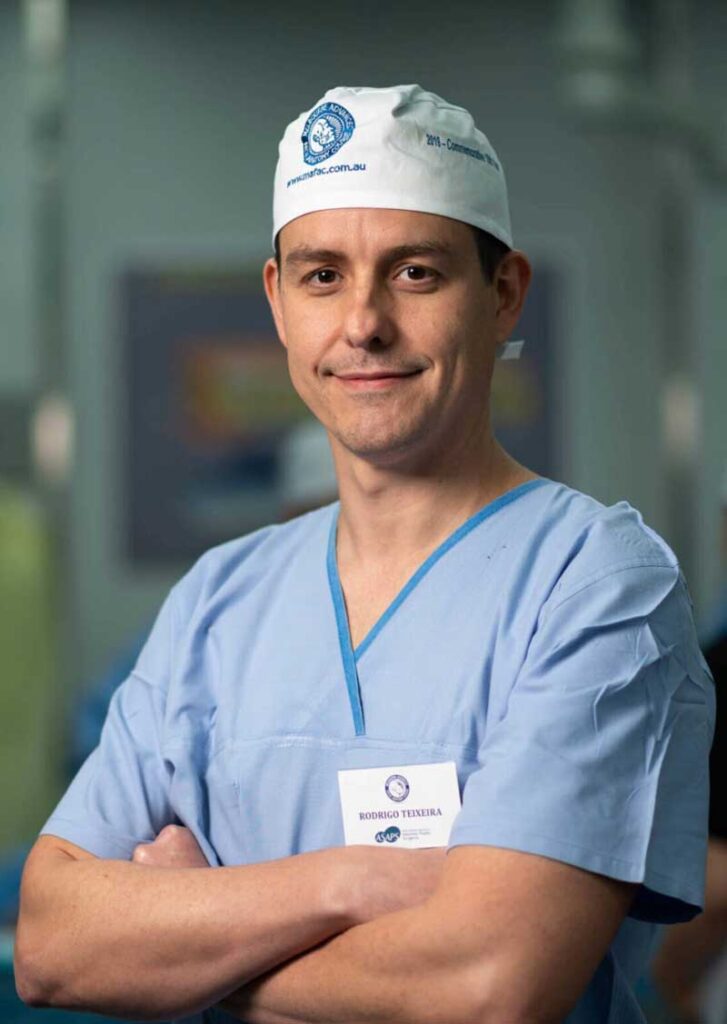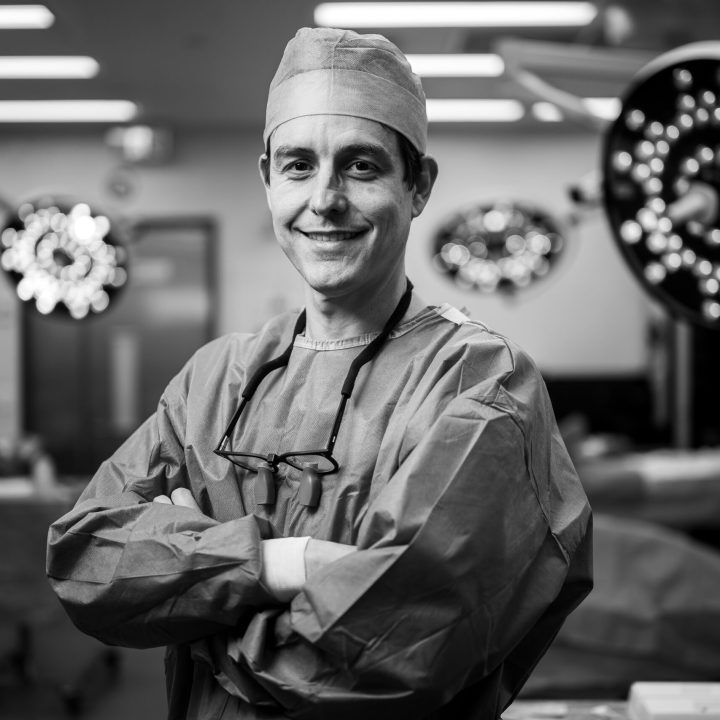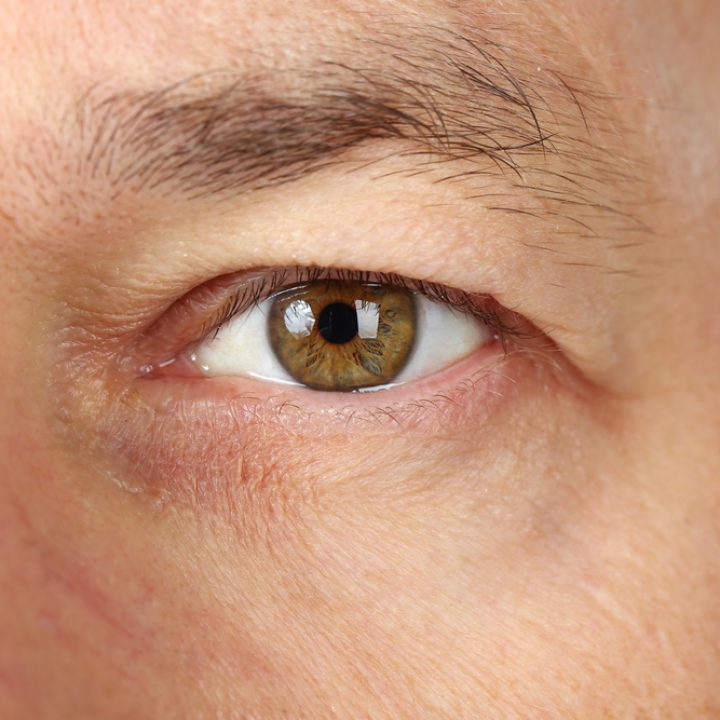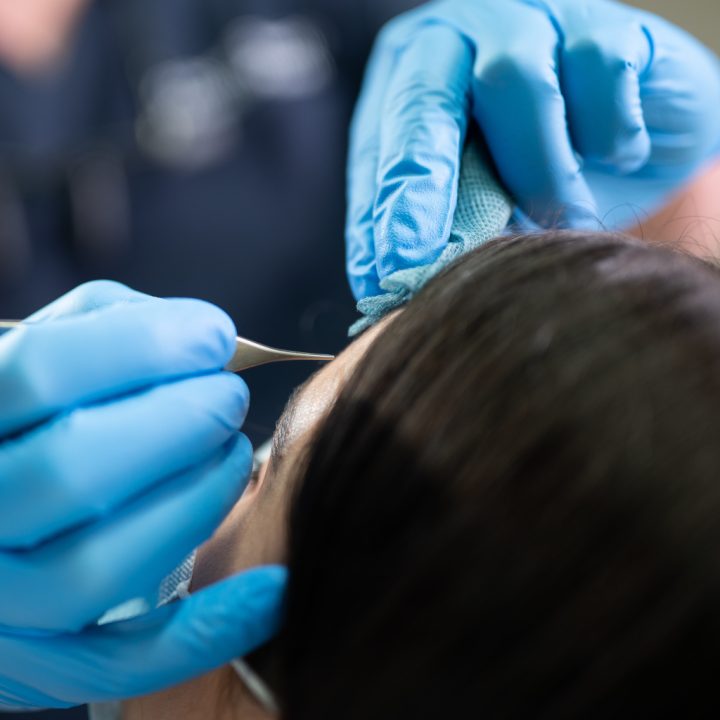Upper Blepharoplasty Melbourne
(Upper Eyelid Surgery)
Upper blepharoplasty in Melbourne with Dr Rodrigo Teixeira (FRACS), Specialist Plastic Surgeon, also known as upper eyelid surgery, is performed to address excess skin, heaviness, and laxity. It may also assist in alleviating functional issues, such as skin that may be partially obstructing vision. Each procedure is carefully planned and tailored to individual anatomy and goals.
What is a Upper Blepharoplasty (Upper Eyelid Surgery)
Blepharoplasty of the upper eyelid is a surgical procedure designed to remove excess skin, muscle, and sometimes fat from the upper eyelids. Ageing, genetics, or certain medical conditions can contribute to skin folds or heaviness in the upper eyelid area, which may change the appearance of the eyes or cause discomfort.
In some cases, excess upper eyelid skin may also obstruct the line of sight. The procedure focuses on addressing this excess skin and may change the contour of the upper eyelids. Individuals may consider upper blepharoplasty for both functional and appearance-related reasons, depending on their specific circumstances.

Learn more about Dr Rodrigo Teixeira and his approach to plastic surgery and patient care.
Our Upper Blepharoplasty (Upper Eyelid Surgery) Techniques
Skin Excision (with or without Orbicularis Resection)
Skin excision remains the foundation of upper blepharoplasty for patients with dermatochalasis, or excess upper eyelid skin. The procedure may involve a limited skin-only reduction or include removal of a narrow strip of the orbicularis oculi muscle to reduce heaviness and bulk. The extent of skin and muscle adjustment is carefully tailored according to eyelid thickness, redundancy, and the desired crease definition, aiming for balance between improvement and natural appearance.
Fat Management and Volume Preservation
A subtle fat bulge on the inner aspect of the upper eyelid is commonly treated with conservative fat removal. However, current techniques now prioritise fat preservation or repositioning to prevent postoperative hollowing, particularly in patients who already show volume loss or a deep upper eyelid sulcus. Fat may be transposed laterally to restore smooth, youthful contour rather than simply removing tissue. This approach helps maintain structure and avoids the flattened or hollow look that can result from over-resection.
Tarsal Fixation (Crease Anchoring)
The creation of a stable and natural-appearing eyelid crease is central to modern upper blepharoplasty. This is achieved by suturing the skin–muscle flap to the tarsal plate or levator aponeurosis, anchoring the crease in a way that moves naturally with eyelid elevation. This technique is especially important for patients with a poorly defined or absent crease, in Asian blepharoplasty (double-eyelid creation), and in revision surgery where crease definition has been lost.
Adjunctive Eyelid Ptosis Repair
In cases where true upper eyelid ptosis (drooping due to levator muscle weakness) is present, levator advancement or aponeurosis repair may be performed at the same time as blepharoplasty. Addressing ptosis during the same procedure helps restore eyelid height, symmetry, and function, providing both aesthetic and functional improvement in a single, comprehensive operation.
Dr Teixeira’s Surgical Approach to Upper Eyelid Blepharoplasty
Dr Rodrigo Teixeira is a Specialist Plastic Surgeon with extensive training and experience in both Cosmetic and Reconstructive Surgery. His approach to upper blepharoplasty combines anatomical precision with a holistic understanding of the periorbital area. He considers how the eyelid, brow, and surrounding tissues age and interact, ensuring each adjustment complements the eye’s natural shape and facial balance.
Every procedure is tailored to the individual’s anatomy, functional needs, and treatment goals. Techniques focus on tissue preservation, crease stability, and proportion, maintaining natural movement and reducing the risk of hollowing. Attention to detail guides all stages of planning and surgery, with consistent emphasis on eyelid function, comfort, and refreshed appearance..

Upper Blepharoplasty Risks and Complications
While upper eyelid surgery carries potential risks and it’s important to understand possible effects and complications before deciding to proceed.
Common or temporary effects may include:
- Swelling or bruising around the eyes
- Mild bleeding or oozing
- Blurred vision or light sensitivity
- Minor asymmetries or irregularities in healing
- Dry eyes or mild irritation
These early changes are usually temporary and improve as tissues heal and lubrication restores comfort.
Less common complications may include delayed wound healing, visible scarring, infection, uneven crease formation, incomplete eyelid closure during early healing, or the need for revision surgery. In rare cases, injury to deeper eye structures or changes in visual acuity may occur. All potential risks are discussed during consultation to support informed decision-making.
Upper Blepharoplasty: What to Expect From Initial Consultation to Recovery
Initial Consultation
The process begins with a comprehensive consultation, during which Dr Teixeira assesses the under-eye area, discusses the patient’s concerns, and reviews their health and medical history. This allows him to create a personalised surgical plan aligned with the individual’s anatomy and expectations. Patients are encouraged to ask questions and discuss what can realistically be achieved through surgery.
Two separate consultations and a mandatory seven-day cooling-off period apply before any cosmetic surgery, in accordance with AHPRA guidelines.
Day of Surgery
On the day of your procedure, you’ll be welcomed by the clinical team and guided through each step. Upper blepharoplasty may be performed in the clinic under local anaesthesia or, in hospital with sedation or general anaesthesia, depending on the plan and your comfort. The operation usually takes one to two hours, followed by a short recovery period for monitoring.
As the anaesthetic wears off, you may notice tightness, mild stinging, or tearing, which usually settles with cold compresses and lubricating drops. You’ll receive written aftercare instructions, including advice to keep your head elevated, avoid rubbing the eyes, and arrange for someone to accompany you home.
Recovery and Aftercare
After upper blepharoplasty, swelling, bruising, and a feeling of tightness or heaviness around the upper eyelids are common during the first week. These gradually improve as healing progresses. Cold compresses, eye lubricants, and sleeping with the head elevated can help reduce discomfort and swelling.
Stitches are typically removed within five to seven days, and most patients return to light daily activities or office work within a week. The eyelids may feel slightly dry or sensitive for several days. As swelling subsides, subtle brow relaxation can change the way the upper lids appear, occasionally leading to mild skin fold recurrence over time. Follow-up appointments with Dr Teixeira and his team ensure close monitoring and support throughout recovery.
Our Melbourne Clinic
Dr Teixeira’s clinic is located in Ivanhoe East, a charming and easily accessible location for patients from across Melbourne and surrounding areas. The clinic offers a modern, welcoming environment with private consultation rooms designed for comfort and confidentiality.
Patients benefit from a supportive team that prioritises professionalism and compassionate care throughout the process. Alongside surgical procedures, the clinic also offers a range of advanced non-surgical treatments that can complement or support recovery and overall rejuvenation.
If you’re considering upper blepharoplasty in Melbourne, you can contact our clinic to arrange a consultation with Dr Teixeira and learn more about your options in a professional and informative setting.
FAQs
The procedure involves removing or repositioning excess skin, muscle, and sometimes fat from the upper eyelids through fine incisions placed in the natural crease, allowing for subtle contour refinement and minimal visible scarring.
Upper blepharoplasty aims to improve eyelid definition and reduce heaviness, not alter the natural shape or expression of the eyes.
Crow’s feet form in the outer eye region and are not corrected by upper blepharoplasty alone. They may be improved with complementary treatments such as skin resurfacing or other non-surgical options.
Yes, if excess upper eyelid skin partially blocks the upper field of vision, removing this skin can relieve heaviness and improve visual function. A Medicare item may apply in documented functional cases.
Swelling and bruising peak in the first few days and settle within 1–2 weeks. Most people return to office work after a week, though subtle changes continue for several months.
Light eye makeup is usually safe after about two weeks, once the skin has healed. Strenuous exercise should be avoided for 2–3 weeks, or until your surgeon advises.
Results are long-lasting, but natural ageing and changes in skin elasticity continue over time. Some patients may seek refinement many years later.
Costs vary with surgical complexity and anaesthesia. Medicare or private insurance may contribute if there is documented visual obstruction meeting specific criteria (MBS 45617).
A secondary procedure may be considered if tissue changes, scarring, or further skin laxity develop over time. Suitability depends on tissue quality and individual healing.





